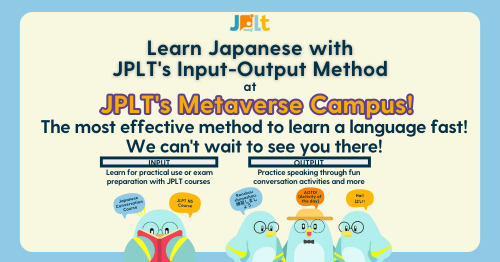Learn a New Language Fast with the Input-Output Method!
Have you ever wondered what the most crucial part of learning a new language is? People believe it is all about input — studying grammar, memorizing vocabulary, and understanding what we hear and read. But is that enough?
Input is important for building a strong foundation in a language. However, to speak and use it effectively, you need output. This means speaking, writing, and actively using the language in real-life situations.
At JPLT, a Japanese online school, we believe balancing input with output is the key to learning Japanese quickly and effectively. It is not just about what you learn; it is about how you use it. That is why we focus on providing plenty of opportunities for you to practice speaking and using Nihongo through conversations, group activities, and more to improve your Japanese proficiency faster.
Experience the Input-Output Method at JPLT’s Metaverse Campus!
The Input-Output Method is the approach we employ at JPLT’s Metaverse Campus, the heart of our learning experience. This virtual space is designed for Japanese learners from all over the world to connect, learn, and have fun — completely free!
But first, let us know more about Input-Output method.
What is the Input-Output Method in Learning?
The Input-Output Method in learning is an approach that emphasizes the balance between absorbing information (input) and actively using that information (output). This method is particularly effective in language learning but can be applied to various educational contexts. Here’s a closer look at what it is:
Input
Input refers to the ways in which learners receive and process new information. In the context of language learning, this includes activities such as:
- Reading: Books, articles, and any written material in the target language.
- Listening: Conversations, audio resources, music, podcasts, and language lessons.
- Watching: Movies, TV shows, and videos in the target language.
The goal of input is to expose learners to correct forms of the language, enriching their vocabulary, grammar, and comprehension skills.
Output
Output involves the active use of the information learned. For language learners, this includes:
- Speaking: Engaging in conversations, practicing pronunciation, and using the language in real-life situations.
- Writing: Creating sentences, paragraphs, essays, or any written content in the target language.
- Interactive Activities: Participating in group activities, language exchange, and other interactive forms of communication.
Output helps reinforce what has been learned, improves fluency, and builds confidence in using the language practically.
In JPLT, we offer numerous “outputs,” such as group activities and conversation clubs, all for you! With the Japanese courses we offer as “inputs,” you can learn effectively in the Metaverse Campus while experiencing a real Japanese environment. With balanced learning, active language use, and practice, you can build communication skills and confidence.
Why Balance is Key
Balancing input and output is crucial because it ensures a comprehensive learning experience. Here’s why:
- Reinforcement: Actively using the language (output) reinforces what has been learned (input), making it more likely to stick.
- Fluency and Accuracy: Input builds accuracy and a strong foundation, while output builds fluency and practical usage skills.
- Confidence Building: Regular practice through output helps build confidence in speaking and writing the language.
- Real-World Application: Output activities simulate real-life situations, preparing learners to use the language outside the classroom.
Implementing the Input-Output Method
To effectively implement the Input-Output Method in language learning, consider the following steps:
- Diverse Input Sources: Use a variety of reading, listening, and watching materials to expose yourself to different contexts and uses of the language.
- Regular Practice: Engage in speaking and writing activities regularly. Join conversation clubs, find language exchange partners, and participate in group discussions.
- Interactive Learning: Use technology and virtual environments, such as JPLT’s Metaverse Campus, to practice in a dynamic and interactive setting.
- Feedback and Improvement: Seek feedback on your output to identify areas for improvement and refine your skills continually.
By balancing input with output, learners can achieve faster and more effective language acquisition, gaining the skills and confidence needed to communicate proficiently.
Whether you’re a beginner or looking to refine your skills, we have something for everyone.
We can’t wait to see you there!
How to enter our JPLT’s Metaverse Campus: https://jplt-dialogplus.com/metaverse/





